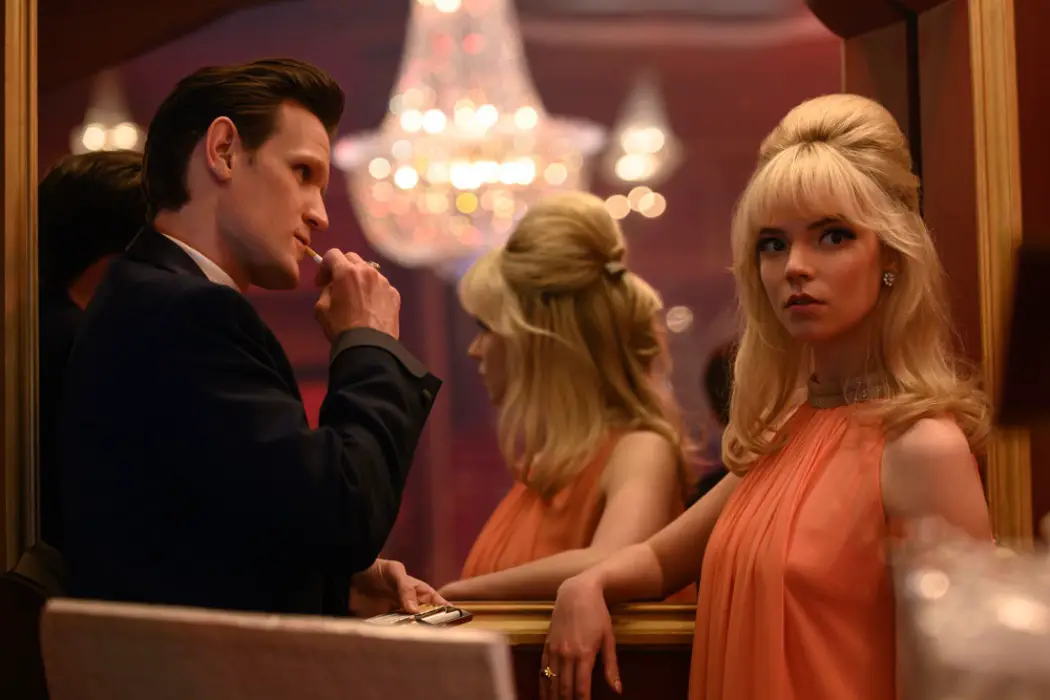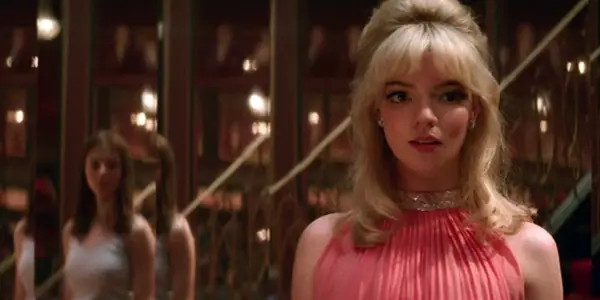LAST NIGHT IN SOHO: There’s A Ghost In My House

Lee Jutton has directed short films starring a killer toaster,…
Many filmmakers wear their influences proudly on their sleeves, though perhaps none quite as prominently as Edgar Wright: he of the well-received homages to zombie splatstick (Shaun of the Dead), buddy-cop movies (Hot Fuzz), and heist flicks (Baby Driver), among others. His latest, Last Night in Soho, takes its inspiration from the stylish psychological horror films of the 1960s and 1970s while also critiquing that era’s treatment of women. The film follows a fashion design student, newly arrived in London, who is able to travel back in time while she is asleep; while hovering on the edges of the past, she witnesses a crime that she attempts to solve in the present. But as the mystery winds its way to its rather predictable conclusion, one is left wishing that there was more to Last Night in Soho than what meets the eye — as nice to look at as it all may be.
Starstruck
Aspiring designer Eloise “Ellie” Turner (Thomasin McKenzie) is infatuated with the idea of London during the Swinging Sixties: the jazzy tunes, the spirited style, the excitement of being on the edge of something new and modern as the cold, hard war years are left in the rearview mirror. When she is accepted to fashion school, she can’t pack her bags fast enough, despite her cautious and caring grandmother (Rita Tushingham) being quick to warn her, “London can be a lot.” Grandma has her reasons for being worried: Ellie’s mother killed herself when Ellie was seven, and Ellie occasionally sees her mother’s ghost hovering in mirrors. And while Ellie reassures her grandmother that she has not had any of those visions in a while, that’s not really the truth.
Immediately upon arriving in London, Ellie is caught off guard by a cabbie whose friendliness quickly crosses the line into creepiness; when she gets to school, her snobbish roommate, Jocasta (Synnøve Karlsen), is quick to seize upon the quiet girl from Cornwall’s homemade outfit and hopeful naivete. Needless to say, when Ellie finds a shabby bedsit for rent near Goodge Street, owned by the elderly Ms. Collins (the late, great Diana Rigg), she seizes the chance to move out of the dorms and embrace the lifestyle of which she has always dreamed.

Those dreams do soon come to life, though not entirely in the way she imagined. While asleep on her first night in her new flat, Ellie is transported back in time to the 1960s, where a confident young woman named Sandie (Anya Taylor-Joy) hopes that Jack (Matt Smith) can help her achieve her goal of becoming a famous singer. When Ellie looks in the mirrors lining the staircase at the Cafe de Paris, she sees Sandie’s catlike eyes staring back; when Jack swings Sandie around the dance floor, Ellie too is swept away by Jack’s charms.
The next morning, Ellie wakes up with a hickey on her neck and a burning desire to go back to sleep and re-enter Sandie’s seemingly glorious world. But soon she realizes that beneath the glitz and glamour of Swinging London is a dark, seedy underbelly where desperate, ambitious women like Sandie are all too easily exploited by men like Jack — men who promise heaven on earth but are only capable of delivering hell. And as Ellie’s dreams devolve into nightmares, the ghosts that populate them begin to haunt her waking hours, too.
Anyone Who Had a Heart
Last Night in Soho is none too obvious about what it’s trying to tell us: the good old days were most definitely not good to everyone. It chides Ellie (and us) for fetishizing the fashions of the past without thinking about the bruises they may have been covering up, for enjoying the music of the era without acknowledging the women who were used and abused by men on their way to stardom—if they made it there at all. It uses the stylish aesthetics of classic psychological horror films such as Don’t Look Now and Repulsion as a vehicle for a lecture about why the time period in which those movies were made was nothing that we should aspire to bring back, no matter how cool it may have looked on the surface.
I’ve read enough Letterboxd reactions to films like What Have You Done to Solange? and, uh, everything Dario Argento has ever touched to know that enough people seem to think this is a message worth repeating, though anyone who truly loves and studies the art of the past knows that yes, it’s often problematic, but yes, one can still enjoy it without getting your feminist identification card revoked. Yet Last Night in Soho feels like Wright’s earnest apology letter to women for enjoying movies like the ones I mentioned above, a murder mystery wrapped around a message of #MeToo solidarity instead of the old-school misogyny that often runs rampant in old thrillers.

The film is gorgeous to look at, courtesy of cinematographer Chung Chung-hoon (Oldboy, The Handmaiden), and features a rollicking retro soundtrack packed with hits by The Kinks, Dusty Springfield, and Siouxsie and the Banshees. When Ellie first travels back in time, and the audience watches her seamlessly switching places with Sandie as both women dance with Jack, one is easily enthralled by this weird, magical world; like Ellie, you’ll want to slip back into it as soon as possible. But the story of Last Night in Soho isn’t quite strong enough, or the message unique enough, to sustain the film once those early thrills have worn off.
The bulk of the blame lies in the heavy-handed script, co-written by Wright with Krysty Wilson-Cairns (1917). You understand exactly what Last Night in Soho is doing the whole time, which isn’t ideal for a movie of this genre; you want to be surprised, shocked, awed, scared. Wright seems to be the one who is scared here — afraid of crossing a line that would get him “canceled,” perhaps — but because of that sense of restraint masquerading as sensitivity, Last Night in Soho doesn’t leave the same mark on the viewer that the best of its predecessors are capable of.
McKenzie brings the appropriate wide-eyed innocence to her role as Ellie; she reminded me of myself when I first touched down at NYU Film School and could just not comprehend the wealth and worldliness of my peers. But I wish we had known more about her history of visions, including those involving her mother. Did her mother have visions too? Is that what drove her to kill herself? Have Ellie’s visions gotten her into trouble in the past? When a police officer asks Ellie if her family has a history of schizophrenia, and she hesitates, one is dying to know what she might be hiding. All of these questions are left unanswered and left me wanting more.

It’s all too easy to understand, however, why Ellie would become so obsessed with Sandie. As played by the charismatic Taylor-Joy, she’s a tragic spitfire, snuffed out by men who aren’t worthy but who hold the power regardless. When Sandie announces she’s going to be the next Cilla Black, you believe her before you’ve heard her sing a single note, such is Taylor-Joy’s natural star power. Smith is perfectly cast as the man who tricks her into falling for him and destroys her life in the process; his unusual face manages to appear handsome from one angle but monstrous from another, making him capable of a Jekyll and Hyde-type performance without any fancy prosthetics. Also impressive are Rigg (in her final role) as the severe Ms. Collins and Terence Stamp as the strange silver-haired man who frequents the bar where Ellie works, these two screen legends both bring a magnetic, mysterious presence to their characters with relatively little screen time.
Much less engaging than these enigmatic elders is John, the fashion school classmate played by Michael Ajao who immediately takes to Ellie despite her shyness and strangeness. This always happens in stories about girls like this; even as everyone around her shuns her for being an oddball, there’s always a boy who somehow sees our heroine for the wonderful, interesting person she truly is. He’s totally not out to take advantage of her; he is truly a “nice guy.” In Last Night in Soho, I kept hoping that Wright would overturn this trope and expose its darker side; after all, if the purpose of this film is to provide a modern twist on old themes, you may as well rip the mask off the pseudo-nice guy too. Instead, John ends up being exactly who he says he is—the cinematic embodiment of “not all men” — which is honestly rather boring. If John had ended up being as savage and controlling in the present day as Jack is in the past, that would have packed a far bigger punch — and, it would have been accurate. Because as much as we might try to pretend things are so much better (albeit less aesthetic) than they were in the Swinging Sixties, some things actually do never change.
Conclusion
Last Night in Soho immediately pulls you in with its colorful visuals and strong performances but it lacks the subtlety necessary to be truly impactful—not to mention, the savagery necessary to be truly horrifying.
What do you think? Are you familiar with the kinds of films that inspired Last Night in Soho? Share your thoughts in the comments below.
Last Night in Soho was released in the U.S. and the UK on October 29, 2021. You can find more international release dates here.
Watch Last Night in Soho
Does content like this matter to you?
Become a Member and support film journalism. Unlock access to all of Film Inquiry`s great articles. Join a community of like-minded readers who are passionate about cinema - get access to our private members Network, give back to independent filmmakers, and more.
Lee Jutton has directed short films starring a killer toaster, a killer Christmas tree, and a not-killer leopard. Her writing has appeared in publications such as Film School Rejects, Bitch: A Feminist Response to Pop Culture, Bitch Flicks, TV Fanatic, and Just Press Play. When not watching, making, or writing about films, she can usually be found on Twitter obsessing over soccer, BTS, and her cat.













